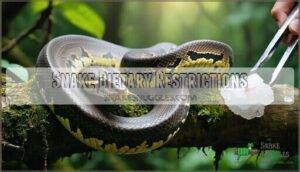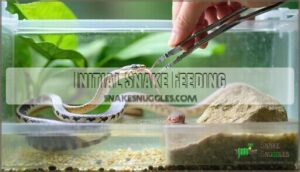This site is supported by our readers. We may earn a commission, at no cost to you, if you purchase through links.

Unlike dogs that eat daily, snakes digest whole prey slowly, making weekly or bi-weekly feeding perfectly natural. The exact schedule depends on your snake’s species, size, and age – ball pythons differ from corn snakes, and a growing yearling needs more frequent meals than a mature adult.
Think of it like filling up a car with a large gas tank versus a motorcycle. Getting the timing right isn’t just about convenience – it’s essential for your snake’s health and can prevent common feeding problems that many owners unknowingly create, which is a critical aspect of responsible pet ownership and requires careful consideration of the snake’s needs.
Table Of Contents
- Key Takeaways
- How Often to Feed a Pet Snake?
- What Do Pet Snakes Eat?
- Snake Dietary Restrictions
- How Often Do Snakes Eat?
- Initial Snake Feeding
- Importance of Choosing Appropriate Food
- Frequency of Feeding
- Understanding Your Snake’s Feeding Habits
- Live Prey Vs. Frozen Prey
- Preparing Food for Your Pet Snake
- Supplements and Vitamins for Your Pet Snake
- Frequently Asked Questions (FAQs)
- How long can a snake go without eating?
- How often do you need to feed a pet snake?
- How do I know if my snake is hungry?
- How much does a snake eat per day?
- What do I do if my snake rejects food?
- How do I humanely kill prey?
- How much water should my snake be drinking?
- What are the signs of overfeeding?
- Can snakes eat during shedding periods?
- What temperature should prey be when serving?
- Conclusion
Key Takeaways
- You’ll feed adult snakes every 7-14 days, while juveniles need meals every 5-7 days – Your snake’s age determines feeding frequency more than anything else, with growing snakes requiring more frequent nutrition than mature adults.
- Your snake’s species and size matter as much as age – Ball pythons differ from corn snakes in their feeding needs, and a small snake burns energy faster than a large one, so you’ll need to adjust schedules accordingly.
- Whole prey like frozen-thawed rodents provides complete nutrition – You don’t need daily feeding like with dogs since snakes digest slowly and efficiently, making weekly or bi-weekly meals perfectly natural for their metabolism.
- Overfeeding causes more problems than underfeeding – You’ll avoid common health issues by sticking to appropriate schedules and prey sizes rather than worrying about missed meals, since snakes can safely fast for extended periods.
How Often to Feed a Pet Snake?
Determining how often to feed a pet snake isn’t one-size-fits-all—it’s like creating a personalized meal plan.
Your snake’s feeding frequency depends on four key factors: species, age, size, and activity level.
Young snake feeding requires more frequent meals than adult snake feeding since growing snakes burn energy faster. Age-based feeding means baby snakes eat every other day, while adults might wait two weeks between meals.
Size-based feeding considers that smaller snakes need twice-weekly feeding, while larger ones can wait longer. Activity-based feeding accounts for energetic snakes requiring more frequent meals.
Monitor your snake’s body condition and adjust accordingly—species schedules vary substantially, making adjusting frequency essential for ideal health.
What Do Pet Snakes Eat?
Understanding what your pet snake eats starts with one fundamental fact: snakes are obligate carnivores who thrive exclusively on animal prey.
Your snake’s wild diets include rodents, birds, amphibians, fish, insects, and eggs, but as a responsible owner, you’ll replicate this through carefully selected snake food types.
Whole prey forms the foundation of proper pet snake diet, with frozen-thawed rodents being the gold standard.
Mice and rats offer excellent rodent nutrition, providing complete protein profiles your snake needs.
Prey variety isn’t just beneficial—it’s essential for health, so consider rotating between different prey types like quail chicks or appropriate-sized rabbits.
Prey size matters tremendously; it should match your snake’s girth at its widest point.
While feeding challenges may arise initially, most snakes adapt well to consistent offerings.
Remember, your snake’s snake feeding habits mirror their wild instincts, so patience during this shift pays off substantially.
Snake Dietary Restrictions
Now that you know what pet snakes eat, you’ll need to navigate their dietary restrictions carefully. Snake dietary restrictions aren’t negotiable – these reptiles have evolved as strict carnivores with zero tolerance for plant matter or processed foods.
Your snake’s evolutionary blueprint demands meat-only meals—no exceptions, no compromises.
Core Dietary Restrictions:
- Carnivorous Diet: Your snake’s species diet must consist entirely of animal-based foods. Vegetables, fruits, grains, and human food will cause severe digestive issues and nutritional deficiencies.
- Prey Size Limits: Never offer prey larger than 1.5 times your snake’s widest body width. Oversized meals lead to regurgitation and potential choking.
- Feeding Environment: Create a quiet, secure space during meals. Stress disrupts digestion and can trigger feeding refusal.
Understanding snake feeding guidelines means respecting their wild diets. In nature, snakes consume whole prey animals that provide complete nutrition. Processed meats lack essential vitamins and minerals found in whole prey.
When planning dietary changes or adjusting your snake feeding schedule, remember that prey variety within appropriate species parameters supports peak health. Ensuring a balanced diet often requires calcium and vitamin D3 supplementation. Stick to these snake feeding frequency principles, and your pet will thrive on their naturally restricted but nutritionally complete diet.
How Often Do Snakes Eat?
How frequently should you feed your snake? Understanding snake feeding frequency isn’t rocket science, but it requires attention to key factors that influence your pet’s appetite and nutritional needs.
Your snake’s feeding schedule depends on four critical elements:
- Species Variation – Different snake species have unique feeding patterns and requirements
- Age Frequency – Younger snakes need more frequent meals than adults due to growth demands
- Size Matters – Larger snakes can go longer between meals than smaller ones
- Activity Impact – More active snakes burn energy faster, requiring frequent feeding
These snake feeding guidelines mirror wild patterns, where feeding frequency varies dramatically based on environmental factors and individual characteristics.
Initial Snake Feeding
Starting your snake’s first meal can feel overwhelming, but proper preparation makes all the difference. Create a quiet and secure feeding area away from distractions, then use feeding tongs to present thawed prey. Gently wiggle the food to trigger your snake’s natural hunting response, following essential snake feeding tips for success.
Handling newborns requires extra patience since younger snakes may be more hesitant. Size introduction matters vitally – start with appropriately sized prey matching your snake’s body width. If your snake shows refusal reasons like stress or improper temperature, don’t panic. Hydration importance can’t be overstated, so make certain fresh water remains available.
This initial snake feeding sets the foundation for healthy eating habits. Understanding a snake’s prey size selection is vital for their digestive health. Your reptile feeding guide should emphasize avoiding handling immediately after meals to prevent regurgitation. Remember, snake feeding frequency varies by age and species, but establishing proper techniques early creates a stress-free routine for both you and your snake.
Importance of Choosing Appropriate Food
Selecting the right food for your snake isn’t just about what looks convenient at the pet store—it’s about ensuring your pet’s long-term health and well-being.
The size, nutritional content, and safety of your snake’s prey directly impact everything from proper digestion to disease prevention, which is crucial for your snake’s overall well-being.
Food Size
Selecting the right prey size directly impacts your snake’s health and digestive capacity.
Choose prey roughly equal to your snake’s thickest diameter vs. girth measurement. This optimal prey size prevents regurgitation risk while ensuring proper nutrition.
A good prey weight ratio equals 10-15% of your snake’s body weight. Young corn snakes start with pinky mice, progressing to fuzzies as they grow.
Getting snake feeding size wrong can cause serious digestive issues, so measure carefully before each feeding.
Nutritional Balance
Proper nutritional balance forms the foundation of your snake’s health and longevity.
Since snakes are obligate carnivores, their balanced diet must come entirely from animal sources to meet their specific needs:
- Protein Requirements: Whole prey provides complete protein profiles essential for muscle development and maintenance
- Vitamin Supplementation: Gut loading prey or occasional supplements guarantee adequate vitamin levels, especially for breeding females
- Mineral Needs: Calcium-phosphorus ratios must stay balanced at 2:1 for proper bone development and metabolic function
Food Safety
Your snake’s health depends on safe food preparation and strict hygiene standards. Source prey from reputable suppliers to minimize bacteria risks and parasite prevention.
Follow proper storage guidelines by keeping frozen prey at consistent temperatures. Practice safe thawing methods using refrigeration or warm water, never room temperature.
Always inspect prey before feeding, checking for signs of spoilage or freezer burn. Consider frozen rodent options for convenient feeding.
Clean feeding tools between uses to maintain proper handling procedures.
Frequency of Feeding
Frequency of Feeding your pet snake depends on multiple factors that work together like pieces of a puzzle.
Age-Based Frequency forms the foundation: hatchlings need meals every 5-7 days, while adults thrive on 10-14 day intervals.
Size-Based Frequency matters too, since smaller snakes burn energy faster than their larger counterparts.
Here’s your feeding frequency snake guide:
- Hatchlings and juveniles: Feed every 5-7 days for proper growth
- Adult snakes: Schedule feedings every 10-14 days depending on species
- Large adult pythons: May only need meals every 2-3 weeks
- Breeding females: Require more frequent feeding during reproductive season
Activity and Feeding patterns also influence your snake feeding habits.
More active snakes need frequent meals, while couch-potato serpents can wait longer.
Species Feeding Needs vary substantially—ball pythons differ from corn snakes in their requirements.
Adjusting Frequency based on your snake’s weight and behavior guarantees the best health.
Remember, there’s no universal snake feeding chart that fits every situation.
Understanding Your Snake’s Feeding Habits
When observing your snake’s feeding habits, you’ll notice their ectothermic nature directly influences their metabolic rates and appetite patterns.
Natural behaviors mirror wild patterns, where snakes hunt based on opportunity rather than schedule. Watch for feeding cues like increased activity, tongue-flicking, or positioning near their usual feeding spot.
Individual variation means each snake develops unique preferences—some strike immediately while others take their time. Understanding these snake feeding habits helps you determine proper feeding frequency and how much to feed.
Create a comfortable and safe feeding environment, monitor weight changes, and adjust schedules based on your snake’s responses for ideal health.
Live Prey Vs. Frozen Prey
When choosing between live versus frozen prey for your snake, you’ll face a decision that impacts safety, convenience, and ethics. Frozen prey benefits far outweigh live prey risks for most snake owners.
| Frozen Prey | Live Prey |
|---|---|
| Eliminates injury risk from defensive bites | Can cause severe wounds and infections |
| Convenient bulk storage and preparation | Requires ongoing care and housing |
| More humane and ethical approach | Creates stress for prey animals |
Prekilled prey offers identical nutritional value while removing dangers. For owners seeking this option, they can find various options available online.
Live rodents can seriously injure your snake through bites, scratches, or escapes that disrupt feeding patterns. Frozen snake food also costs less long-term and stores easily in your freezer.
Most captive snakes readily accept live snake food alternatives once properly thawed and warmed. While some owners believe live feeding stimulates natural behaviors, the ethical considerations and safety concerns make frozen options the smarter choice. Your snake’s snake preference typically adapts quickly to this safer feeding method.
Preparing Food for Your Pet Snake
Before you feed your snake, proper preparation guarantees your pet’s safety and health.
Thawing frozen prey correctly prevents bacterial growth, while safe handling practices protect both you and your snake from contamination or injury.
Essential preparation steps include:
- Thawing frozen prey in the refrigerator overnight or using warm water for faster results
- Following a prey size guide to match food width to your snake’s thickest body section
- Using safe handling practices with feeding tongs instead of bare hands
- Maintaining proper hygiene by washing hands and disinfecting surfaces before and after
- Creating a quiet feeding environment away from distractions and household activity
Whether you’re using live snake food, prekilled prey, or frozen-thawed prey, temperature consistency matters. Many owners opt for convenient, frozen options for their snakes. Room temperature or slightly warm prey triggers better feeding responses than cold food straight from storage.
Supplements and Vitamins for Your Pet Snake
Most snakes thrive on whole prey diets without requiring additional vitamin supplements. However, understanding supplement types can help you make informed decisions about your pet’s health.
Calcium and vitamin D3 work together to maintain proper mineral balance and bone health, especially essential for growing snakes.
Natural sources like healthy, well-fed prey animals typically provide complete nutrition. Watch for signs of vitamin deficiencies such as poor appetite, lethargy, or respiratory issues.
If supplementation becomes necessary, follow strict dosage guidelines from your reptile veterinarian. Over-supplementing risks include kidney damage and metabolic disorders.
Remember that vitamin A is vital for snake health. Think of supplements as insurance rather than daily necessities. Most captive snakes receiving proper whole prey diets won’t need them.
When in doubt, blood work can reveal nutritional deficiencies before symptoms appear. Remember, a balanced approach prevents both deficiency and toxicity issues.
Frequently Asked Questions (FAQs)
How long can a snake go without eating?
Like hibernating bears, snakes can survive surprisingly long fasting periods. Adult snakes typically go 2-4 months without eating, while juveniles need food every few weeks to support growth and development.
How often do you need to feed a pet snake?
Your snake’s feeding schedule depends on its age and size.
Baby snakes need meals every 5-7 days, juveniles eat weekly, and adults typically require feeding every 10-14 days for peak health.
How do I know if my snake is hungry?
Watch for increased activity around feeding time, tongue flicking, hunting posture, or following movement.
Your snake might also position itself near the enclosure’s front, appearing more alert and responsive than usual, with behaviors such as tongue flicking.
How much does a snake eat per day?
Pet snakes don’t eat daily.
They’re fed every 5-14 days depending on age and species.
Young snakes eat twice weekly, while adults eat weekly or biweekly, consuming prey totaling about 10% of their body weight per feeding.
What do I do if my snake rejects food?
Don’t panic if your serpent suddenly snubs dinner—this happens frequently.
Check temperatures first, make certain proper humidity levels, then try offering different prey sizes or types.
Sometimes snakes fast naturally, especially during breeding season or winter months.
How do I humanely kill prey?
Most pet snake owners buy pre-killed frozen prey from reptile suppliers or pet stores rather than killing live animals themselves.
This eliminates ethical concerns while providing safe, convenient nutrition for your snake.
How much water should my snake be drinking?
Your snake doesn’t actively "drink" water like mammals do.
They absorb moisture through their skin while soaking and get hydration from their prey.
Provide a clean water bowl for occasional soaking needs, which can help with hydration from their environment.
What are the signs of overfeeding?
Overfeeding shows up as rapid weight gain, sluggish behavior, and refusing meals.
You’ll notice your snake’s body becoming thick and rounded rather than maintaining its natural sleek shape, signaling it’s time to adjust portions.
Can snakes eat during shedding periods?
Most snakes won’t eat during shedding since they’re stressed and can’t see well. You’ll notice their eyes turn milky blue, signaling they’re entering this phase and should skip meals temporarily.
What temperature should prey be when serving?
Warming prey to the right temperature isn’t rocket science—you’ll want it around body temperature, roughly 98-100°F.
Thaw frozen prey completely, then warm it using warm water or heating pads until it feels naturally warm to touch.
Conclusion
Many snake owners worry they’ll underfeed their pet, but overfeeding actually causes more health problems than occasional missed meals.
Understanding how often to feed a pet snake removes this guesswork completely. You’ve learned that adult snakes thrive on weekly or bi-weekly meals, while juveniles need more frequent feeding every five to seven days.
Remember, your snake’s species, age, and size determine the exact schedule. With proper timing and appropriate prey size, you’ll maintain your snake’s health while avoiding common feeding mistakes that stress both pet and owner.
- https://thereptilepro.com/feeding-a-pet-snake/
- https://www.quora.com/How-often-do-pet-snakes-need-to-be-fed-and-what-should-you-feed-them-when-they-arent-feeding-on-live-prey-if-so-any-suggestions
- https://talis-us.com/blogs/news/the-importance-of-proper-snake-pet-diet-a-comprehensive-guide-1?srsltid=AfmBOopS2gWHvLiJMBDwaxPtrXn-zw_Dn275Y9x3IQ6B5NOjQldmIwTn
- https://vetverified.com/articles/a-new-owners-guide-to-feeding-your-pet-snake
- https://vetexplainspets.com/how-often-should-you-feed-a-snake/














